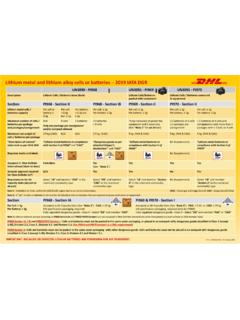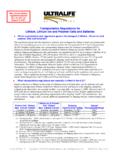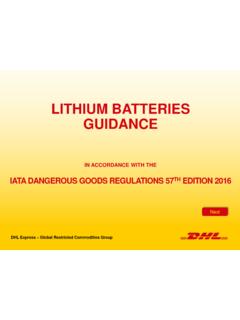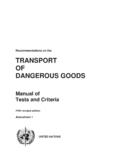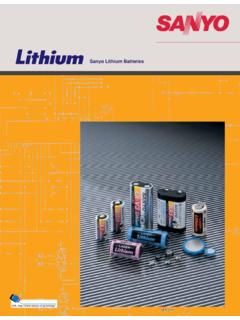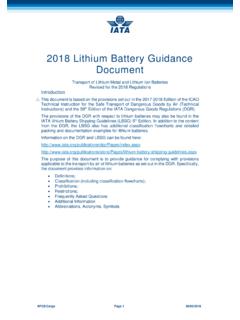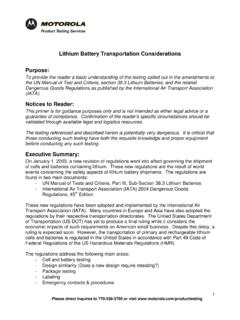Transcription of U.S. DEPARTMENT OF TRANSPORTATION NEW …
1 DEPARTMENT OF TRANSPORTATION NEW lithium battery rules Pursuant to HM-224F The DEPARTMENT of TRANSPORTATION (DOT) has adopted many of the requirements currently in place in the 2013-2014 International Civil Aviation Organization s (ICAO) Technical Instructions for Safe Transport of Dangerous Goods by air. Therefore, ground transport of lithium batteries are now more closely aligned with the 55th edition of the IATA Dangerous Goods Regulations, which are more stringent than the rules previously in place for ground shipments. These rules will help to standardize for shippers the way in which lithium batteries and equipment powered by such batteries are shipped. DOT has not made the lithium battery regulations more stringent than ICAO to avoid any undue negative impact on battery manufacturers or shippers. Here are six things you need to know about the new rules : 1. NEW PROPER SHIPPING DESCRIPTIONS Effective with this rule change, there will be six unique basic shipping descriptions listed in the HMT, instead of just two descriptions prior to the rule changes.
2 Proper Shipping Name ID Number Hazard Class PG lithium ion batteries UN3480 9 II lithium ion batteries contained in equipment UN3481 9 II lithium ion batteries packed with equipment UN3481 9 II lithium metal batteries UN3090 9 II lithium metal batteries contained in equipment UN3091 9 II lithium metal batteries packed with equipment UN3091 9 II NOTE: lithium ion batteries include lithium ion polymer batteries. NOTE: lithium metal batteries include lithium alloy batteries. 2. ADOPTION OF WATT-HOUR RATINGS FOR lithium ION BATTERIES Prior to the new rules , shippers have had to use equivalent lithium content (ELC) as a measure of energy in a lithium ion battery . ICAO/IATA and IMDG have long used the more typical and easier to obtain Watt-hour (Wh) rating. Beginning in 2016, battery manufacturers will be required to mark each lithium ion battery with the Wh rating; DOT is removing all references to ELC and adopting Wh. DOT is not changing the values the shipper uses to determine if a lithium battery is small , and therefore excepted from the regulations.
3 SMALL lithium metal cells are those containing 1 g lithium per cell or 2 g lithium per battery . These are still excepted . SMALL lithium ion cells are those rated at 20 Wh per cell or 100 Wh per battery . These are also still excepted . However, refer to the Exceptions sections 4 and 5 for further information. 3. REVISION, REMOVAL AND CONSOLIDATION OF MOST SPECIAL PROVISIONS DOT has removed, consolidated and relocated many of the special provisions related to lithium batteries. The small lithium battery exception and the medium lithium battery exception , which were previously found in DOT special provisions 188 and 189, respectively, have been revised and relocated to 49 CFR (c). This is the packaging section for lithium batteries referenced in column 8 of the hazardous materials table. 4. THE SMALL lithium battery EXCEPTION (Previously DOT SP 188) This is the most significant change in the new regulation. Prior to the new regulations, shippers of small lithium batteries have enjoyed significant regulatory relief in ground shipment of the batteries.
4 For example, most packages containing 24 cells or 12 batteries were not required to be marked that they contained lithium batteries, and they were not required to be accompanied by any special documentation. In order to align with ICAO/IATA, DOT has changed this exception, especially as it relates to package testing and hazard communication. According to the new DOT regulations, battery packages being shipped by ground must be marked and labeled the same way as they have been for shipment by air. See charts below for new requirements. NEW PACKAGE REQUIREMENTS FOR EXCEPTED SMALL lithium BATTERIES GROUND (Packages do NOT need to be UN certified) What is in the package? How many? Package Tests Package Weight Limits lithium ion batteries 1 or more m drop test 66 lb. (30 kg) gross lithium ion batteries contained in equipment 1 or more None None lithium ion batteries packed with equipment 1 or more m drop test None lithium metal batteries 1 or more m drop test 66 lb. (30 kg) gross lithium metal batteries contained in equipment 1 or more None None lithium metal batteries packed with equipment 1 or more m drop test None Button cells contained in equipment Unlimited None None NEW HAZARD COMMUNICATION REQUIREMENTS FOR EXCEPTED SMALL lithium BATTERIES - GROUND What is in the package?
5 How many? lithium battery Warning Label? Primary lithium Batteries Forbidden for Transport Aboard Passenger Aircraft lithium Warning Document? lithium ion batteries 1 or more Yes No Yes lithium ion batteries contained in equipment 4 cells or 2 batteries No No No lithium ion batteries contained in equipment > 4 cells or 2 batteries Yes No Yes lithium ion batteries packed with equipment 1 or more Yes No Yes lithium metal batteries 1 or more Yes Yes, this marking is required regardless of the number of batteries in the package Yes lithium metal batteries contained in equipment 4 cells or 2 batteries No Yes, but only if the package contains more than 11 lbs (5 kg) net weight of batteries No lithium metal batteries contained in equipment > 4 cells or 2 batteries Yes Yes, but only if the package contains more than 11 lbs (5 kg) net weight of batteries Yes lithium metal batteries packed with equipment 1 or more Yes Yes, but only if the package contains more than 11 lbs (5 kg) net weight of batteries Yes Note that the lithium battery warning label may be the red bordered label used in IATA or an alternative marking that includes all required information.
6 The lithium warning document is NOT a hazmat bill of lading, but can be printed on the BOL. The document is required per shipment, not per package. Packages containing only button cell batteries installed in equipment do not need to display any marks or labels or be accompanied by any document. Requirements for the shipment of small lithium cells and batteries by air under 49 CFR are now identical to those found in Section II (or 1B) of the relevant IATA packing instructions. Please refer to the 49 CFR or IATA regulations for complete requirements. 5. THE MEDIUM lithium battery EXCEPTION (Previously DOT SP 189) DOT has retained this exception for lithium metal cells containing up to 5 grams of lithium and lithium metal batteries containing up to 25 grams of lithium . lithium ion cells rated up to 60 Wh and lithium ion batteries rated up to 300 Wh are also included in this medium category. Shipment of these batteries is authorized for ground and rail TRANSPORTATION only.
7 All packages, regardless of the number of batteries, must be marked with the words: lithium BATTERIES FORBIDDEN FOR TRANSPORT ABOARD AIRCRAFT AND VESSEL. 6. OTHER CHANGES In addition to the changes described above, DOT has also changed the requirements for prototype battery shipments and for the shipment of lithium batteries and cells for disposal or recycling. Additionally for battery manufacturers, DOT has adopted the requirement that they retain a record that the batteries and cells they ship have passed UN testing. This record must be retained for the time that the battery is shipped and for one year thereafter. Please note that the information contained herein is by no means complete, inclusive, or exhaustive. It is intended as a summary guide and is not adequate for compliance purposes. Always refer to the most recent edition of the hazardous materials regulations for complete requirements. Access to the most recent hazmat regulations can be found on the PHMSA website.
8
